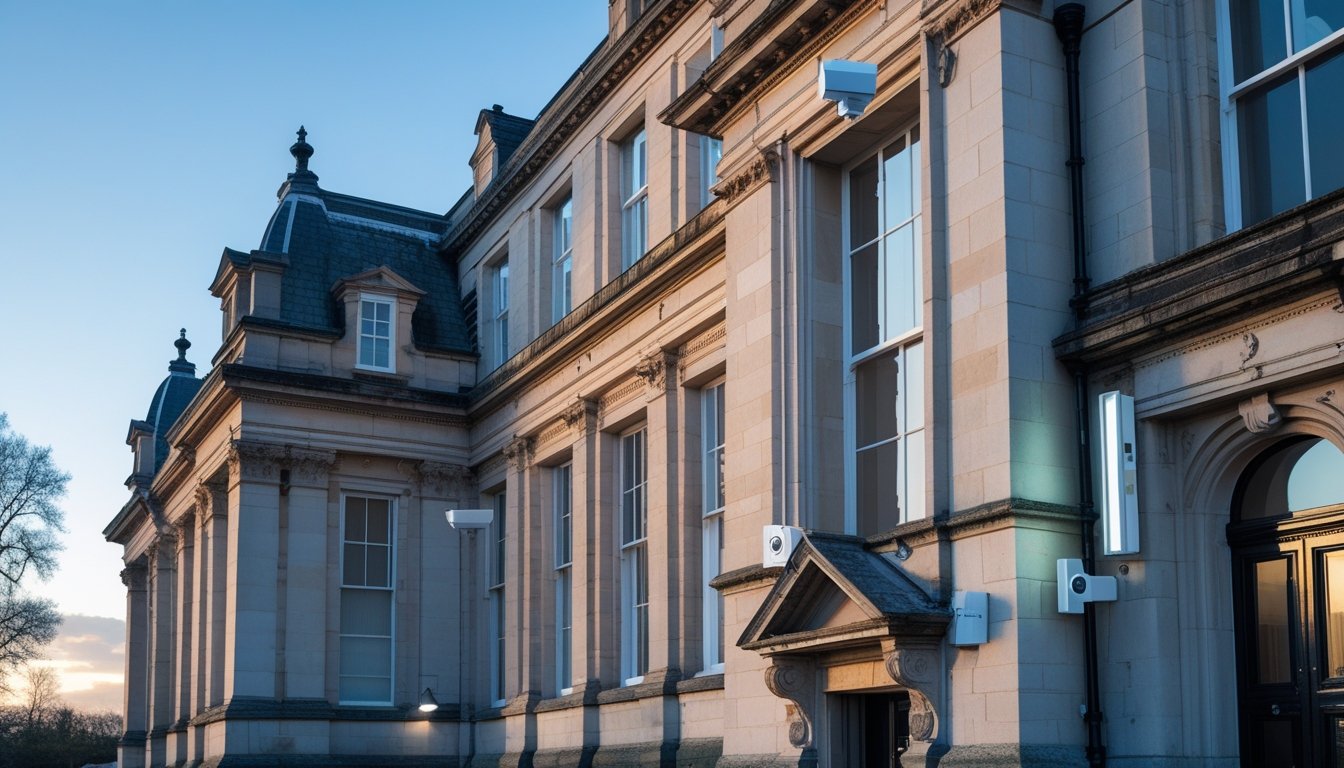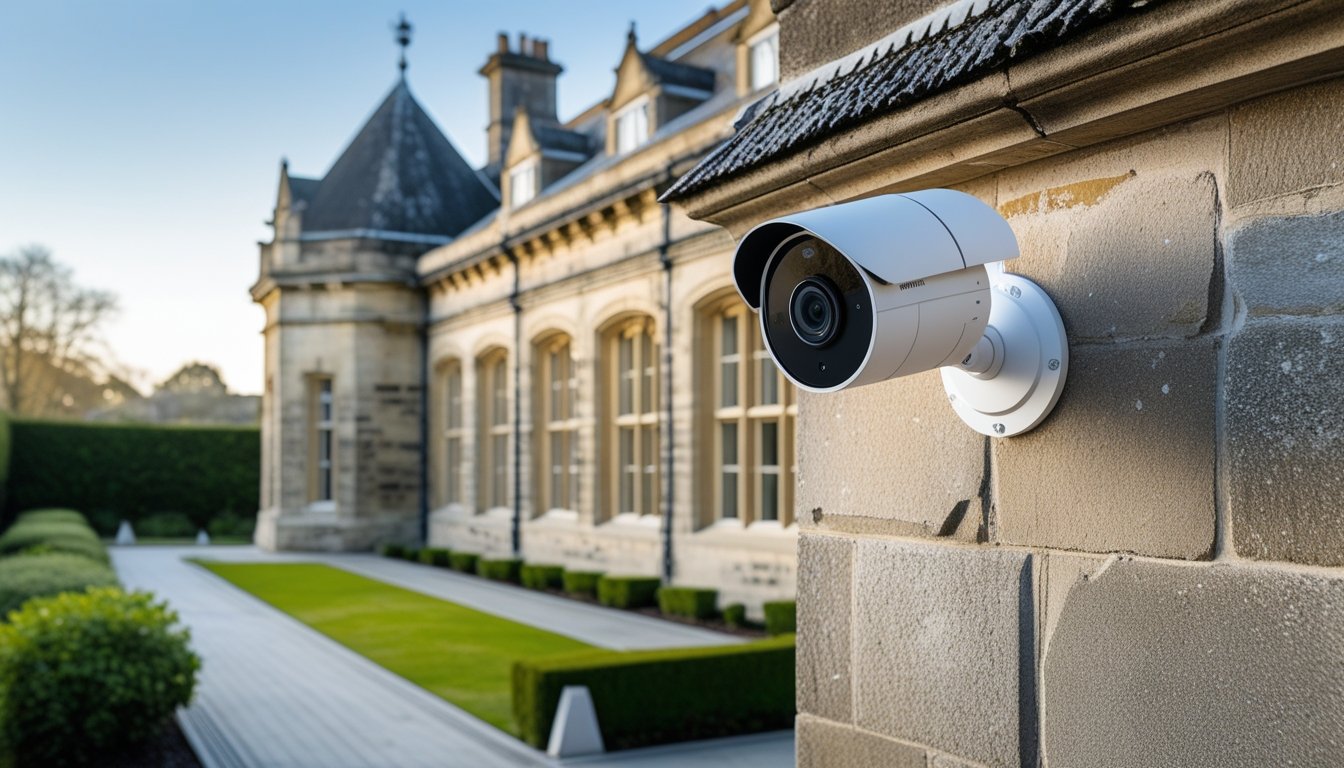Late updated: 31 Oct 2025 14:10
Written by: Elena Prescott
Protecting Listed Buildings With Modern Security Solutions: Balancing Heritage and Innovation
Listed buildings are more than just structures; they are time capsules preserving our cultural and architectural heritage. Balancing the charm and historical significance of these properties with the demands of modern security offers a unique challenge. To safeguard them without compromising their integrity, we need to implement innovative security measures that are both effective and sympathetic to their historical context.

As we explore the best practices for protecting these sites, it becomes clear that conventional security solutions often fall short. The key lies in employing advanced technologies that can seamlessly integrate with the architectural fabric of these buildings. From wireless access control systems to non-invasive perimeter security, these methods have been specifically tailored for heritage properties.
Enhancing the preservation efforts for listed buildings requires meticulous planning and a bespoke approach. Our aim should always be to protect the invaluable without altering the essence of what makes these buildings remarkable. By striking this delicate balance, we can ensure these historic treasures are enjoyed by future generations.
Key Takeaways
- Modern technologies protect listed buildings effectively.
- Integrated approaches balance security and preservation.
- Tailored solutions respect historical integrity.
Modern Security Strategies for Listed Buildings

In adapting modern security for listed buildings, our focus should be on solutions that respect historical architecture while enhancing safety. Balancing heritage with technology requires strategic integration to maintain both security and the aesthetic value of these structures.
Integrating Advanced Security Solutions with Period Architecture
The integration of advanced security solutions with period architecture demands a meticulous approach. We must ensure that any new installations do not disrupt the historical character of these buildings. For instance, using covert security technologies that harmonise with architectural elements can provide effective protection while remaining invisible to the casual observer.
Consider wireless alarm systems, which are less invasive than traditional wired setups. These systems can be installed without extensive modifications to the structure, thereby preserving the historic fabric. CCTV cameras can also be discreetly placed within architectural niches or designed to blend with existing features, ensuring they are unobtrusive yet functional.
Electronic Access Control Systems and Keyless Entry
Utilising electronic access control systems in listed buildings can significantly enhance security. Keyless entry technologies, such as smart cards and biometric systems, offer robust access control while eliminating the need for invasive keyholes or traditional locks.
The flexibility of these systems allows us to control and monitor access to sensitive areas without altering the building's appearance. Additionally, the ability to seamlessly integrate time-sensitive access controls ensures that only authorised personnel can enter restricted zones during specific times, providing an extra layer of security.
These systems help maintain the building’s structural integrity by avoiding physical contact damage and reduce the need for regular maintenance associated with conventional locks. Moreover, regular updates to these technologies can adapt to emerging security challenges, ensuring continued protection.
Remote Monitoring and Discreet Surveillance Technologies
Remote monitoring offers peace of mind by allowing us to observe listed properties in real-time, even from afar. Technologies such as IP cameras and smart sensors facilitate continuous surveillance without compromising the property's aesthetics.
These solutions offer the ability to remotely access video feeds, monitor environmental conditions like temperature and humidity, and receive alerts on potential security breaches. Discreet surveillance technologies, such as miniaturised cameras and hidden microphones, can be strategically embedded to monitor activities while respecting privacy and preserving architectural aesthetics.
Implementing such systems provides a practical approach to safeguarding listed buildings while aligning with conservation efforts. They grant us the ability to respond swiftly to incidents and keep these cultural landmarks secure at all times.
Balancing Preservation and Security in Heritage Properties
Safeguarding heritage sites and listed properties demands a careful approach that respects historical significance while incorporating modern security technologies. This balance ensures that these cultural treasures remain intact and secure for future generations, respecting their authenticity and historical value.
Maintaining Authenticity While Upgrading Security Measures
When we upgrade security in heritage properties, it's crucial to maintain their original character. Using advanced yet discreet technologies can help us protect these sites without compromising their aesthetic appeal.
For instance, small-scale surveillance cameras and alarm systems can be installed subtly. Wireless sensors and hidden wiring ensure that the infrastructure remains largely unaltered. In this way, we preserve the visual charm while enhancing safety. Authenticity isn't just about appearance; it encompasses the entire historical narrative, which we strive to maintain even with modern security additions.
Professional Guidance and Regulatory Compliance
Engaging professionals who specialise in heritage conservation is essential. They guide us through complex regulations and ensure compliance with legal standards. The Secretary of the Interior's Standards provide valuable insights on managing these properties.
Meeting these stringent guidelines requires an understanding of the intricate balance between preservation and necessary modernisation. Our efforts must align with local planning permissions and conservation rules. Navigating these nuances ensures that heritage sites remain protected and legally compliant while we integrate contemporary security measures.
Tailored Security for Heritage Sites and Listed Properties
No two heritage sites share the exact same security needs. Custom solutions are thus necessary for each site. We might employ cloud-based platforms for remote monitoring or mobile credentials for access control, depending on specific requirements.
Furthermore, intelligent lighting and responsive security alarms can provide additional layers of protection. Tailoring these systems to site-specific challenges enables us to address vulnerabilities efficiently without stripping properties of their distinctive character. Customised strategies are designed to blend with the essence of each heritage site, ensuring robust security while maintaining their unique historical identity.
Frequently Asked Questions

Incorporating modern security systems into listed buildings requires careful consideration to maintain their historical value. Balancing legal requirements with technological advances ensures that the integrity of these structures is preserved while enhancing security.
How can modern security systems be integrated into historic structures without affecting their integrity?
To achieve this, we must use technologies that blend seamlessly with the existing architecture. Covert security solutions like hidden cameras or sensors can provide protection without compromising the building’s appearance. Wireless systems are often preferred, as they require minimal structural alterations.
What are the legal implications of altering a listed building for the installation of security features?
Before making modifications, it is essential to consult local preservation offices or national registries. Regulations vary, but typically, any proposed changes must be approved to ensure they comply with guidelines aimed at preserving the building's heritage and architectural value.
What types of security technologies are most appropriate for use in heritage properties?
Discreet technologies such as wireless security systems, advanced lock mechanisms, and motion detectors are ideal. They offer protection while being unobtrusive. It's crucial to select systems that require minimal alteration to the building's existing structure or aesthetic.
How does the conservation of listed buildings impact the choice of security measures?
Conservation priorities dictate the use of non-invasive security options. Equipment should be chosen that enhances security without interfering with the building’s fabric. This often requires innovative solutions that respect both the historical essence and modern needs.
In what ways can security enhancements be made to respect the aesthetic value of listed buildings?
Maintaining visual harmony is key. We can achieve it by choosing security devices that are visually compatible with the building's existing aesthetics or by using concealed installations. Collaborating with architects and preservationists ensures that any interventions are sympathetic to the original design.
What best practices should be followed when planning and implementing security systems in protected heritage sites?
Thorough planning and collaboration with conservation experts are fundamental. Detailed assessments help in identifying the most suitable technologies that meet security needs without violating preservation standards. Regular training for onsite personnel ensures that the systems are used effectively and sustainably.
